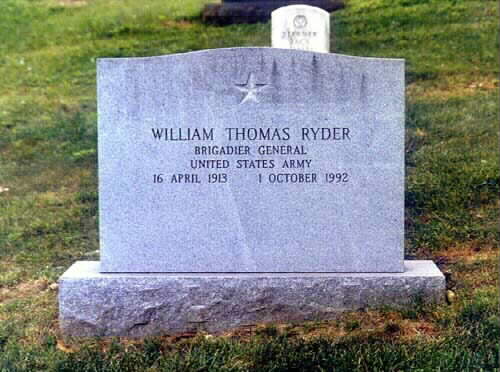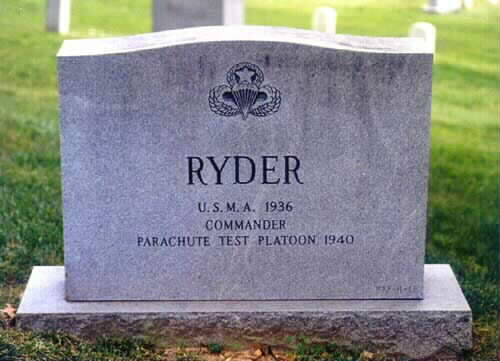From a press report: October 27, 1992
No one knew, in the early morning hours of June 26, 1940, that a reputation was being born.
But when First Lieutenant William T. Ryder stepped forward on that hot summer morning at Fort Benning, Georgia, and volunteered for what to many seemed like another cockeyed scheme dreamed up by the Army brass, he secured for himself a place in history.
Ryder became, officially, the Army's first paratrooper.
On Friday, with the solemn pomp that was his due, retired Brigadier General William T. Ryder, 79, of Pinehurst was laid to rest. A military career that began in 1932 with the long gray line of cadets at West Point ended 60 years later with the playing of “Taps” among the long white rows of tombstones at Arlington National Cemetery.
But Ryder did more than just be the first man out the door of a C-33 transport flying 1,500 feet above Georgia in 1940. He set the standard and the style for paratroopers. He made them think of themselves as elite troops, the best-dressed and the toughest and the best-looking soldiers in the world.
That reputation lives on today. Although the standard Army hat is a sad-looking affair, be it the camouflage fatigue cap or the green dress hat, paratroopers at Fort Bragg wear jaunty maroon berets. And although the dress uniform calls for black shoes, paratroopers strut in highly polished jump boots. Paratroopers think they can do more push-ups and run faster and farther and fight harder when they get there.
It wasn't that way at first. Ryder was among hundreds of officers and enlisted men who volunteered for something being called the “parachute test platoon” at Fort Benning in 1940. The U.S. Army, after watching the early success of German and Russian paratroopers, wanted to see whether Americans could do it too. Ryder, who had been learning and writing about paratroopers, was chosen to command the test platoon and find out whether U.S. soldiers could cut it.
Ryder chose only unmarried men because it was so dangerous. He chose only those in excellent physical condition. He chose only experienced infantrymen and he worked them all summer. Soon the three miles a day they ran got boring, so the men themselves upped the ante to five miles a day in the Georgia heat. To simulate a parachute landing, they jumped from the backs of moving trucks. Every mistake, no matter how minor, was punished with push-ups. They studied tactics and what little was know n about parachuting. They jumped from amusement park towers that gave simulated parachute rides. They learned to pack their own parachutes while blindfolded. And they wore those dashing paratrooper boots.
On August 16, 1940, Ryder lined his hardened men up at the airstrip and they began loading. The demonstration they had seen the day before must have been weighing heavily on their minds. They had watched as a 150-pound dummy simulated a parachute drop and smashed to the ground 50 feet in front of them when its parachute didn't open.
The plane reached 1,500 feet and as it passed over the field where the rest of the test platoon watched and waited, Ryder stepped out the door and into history. He was followed by eight other enlisted paratroopers. There were supposed to be 10 altogether, but the man chosen by lots to be the first enlisted paratrooper froze and William “Red” King got the honor.
Hundreds of thousands of paratroopers followed Ryder and the test platoon, jumping into battle in Sicily, Normandy, Munsan, Vietnam, Grenada and Panama. The difference was, they had that cocky paratrooper confidence because Lt. William Ryder and those he led had the guts to go first.
As a First Lieutenant he commanded the first Airborne test platoon in 1940 and was the first American officer to make a parachute jump under than emergency conditions. He made jumps into both North Africa and Sicily in World War II before being transferred to the Pacific Theater and to the staff of General Douglas MacArthur.
He was buried in Arlington National Cemetery on October 23, 1992 in a ceremony attended by two of the remaining 18 members of the original test platoon, former and present members of the 82nd Airborne Division and his widow, Muriel, who he met in the Pacific while she was serving in the Red Cross there. The real father of American Airborne warfare.
Michael Robert Patterson was born in Arlington and is the son of a former officer of the US Army. So it was no wonder that sooner or later his interests drew him to American history and especially to American military history. Many of his articles can be found on renowned portals like the New York Times, Washingtonpost or Wikipedia.
Reviewed by: Michael Howard


